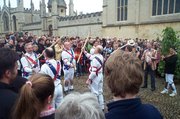Morris dance
|
|
A Morris dance is a form of folk dance.
CotswoldMorrisHandkerchiefs20040501_CopyrightKaihsuTai.jpg
There are records mentioning the Morris Dance dating back to 1477, and it is mentioned in Renaissance documents in France, Italy, and Spain. The origins of the term are uncertain, but one of the most widely accepted theories is that the term was "moorish dance" and "Moresco", which was gradually corrupted to "Morris Dance". Another is that it derives from the Romanian "morisca", which means "little mill". [1] (http://www.angelfire.com/folk/hora/)
In the modern day, it is commonly thought of as a uniquely English activity, although there are around 150 Morris teams in the United States. Expatriates form a larger part of the morris tradition in Australia, Canada, New Zealand, and Hong Kong. The dance is also practised in Barcelona, Spain, where it is performed by girls or women, and in Utrecht, Netherlands. The traditional Căluşari dance of Romania resembles morris in many ways. [2] (http://www.vancouvermorrismen.org/calusari.html)
| Contents |
History in England
Before the English Civil War, the working peasantry often took part in Morris dances, especially at Whitsun. The Puritan government of Oliver Cromwell, however, suppressed Whitsun Ales and other such festivities. When the crown was restored by Charles II, the springtime festivals were restored. In particular, Whitsun Ales came to be celebrated on Whitsunday, as the date coincided with the birthday of Charles II.
Morris dancing continued in popularity until the industrial revolution and its accompanying drastic social change. Four current teams claim a continuous lineage of tradition within their village: Abingdon, Bampton, Headington Quarry and Chipping Campden. Other villages have revived their own traditions, and hundreds of other teams across the globe have adopted (and adapted) these traditions, or have created their own styles from the basic building blocks of morris stepping and figures.
Several English folklorists were responsible for recording and reviving the tradition in the early 20th century, often from a bare handful of surviving members of mid-19th-century village sides. Among these, the most notable are Cecil Sharp, Maud Karpeles, and Mary Neal. Boxing Day 1899 is widely regarded as the signal starting point for the morris revival. Cecil Sharp was visiting at a friend's house in Headington, near Oxford, when the Headington Quarry morris side arrived to perform. Sharp was greatly inspired by the performance, and began collecting dances. Mary Neal, a teacher in London, was looking for dances for her girls to perform, and so the first revival performance was by schoolgirls in London.
In the first few decades of the 20th century, several new men's sides were formed, and in 1934 the Morris Ring was founded by six revival sides. In the 1960s and especially the 1970s, there was an explosion of new dance teams, many of them women's or mixed sides. At the time, there was often heated debate over the propriety and even legitimacy of women dancing the Morris, though this had largely subsided by the end of the 20th century.
Styles
Today, there are three predominant styles of Morris Dancing, and different traditions within each style named after their village of origin. Traditions differ in the form of their steps and capers.
- Cotswold Morris: dances from the English Cotswolds, normally danced with handkerchiefs or sticks to embellish the hand movements
- North West Morris: more military in style and often processional. Clogs are a characteristic feature of this style of dance
- Border Morris from the English-Welsh border: a simpler, looser more vigorous, style, normally danced with blackened faces (or otherwise colored, given the negative connotations of blackface) and wearing rag coats, vests or shirts.
NorthWestMorris20040501_CopyrightKaihsuTai.jpg
Lionel Bacon records morris traditions, most of which are in the Cotswold style, from these villages: Abingdon, Adderbury, Ascot-under-Wychwood, Badby, Bampton, Bidford, Bledington, Brackley, Brimfield, Bromsberrow Heath, Bucknell, Ducklington, Evesham, Eynsham, Headington Quarry, Hinton-in-the-Hedges, Ilmington, Kirtlington, Leafield ("Field Town"), Leominster, Lichfield, Longborough, Much Wenlock, Oddington, Pershore, Sherbourne, Stanton Harcourt, Steeple Claydon, Upton-on-Severn, Upton Snodsbury, Wheatley, White Ladies Aston, Winster.
Sometimes regarded as a form of Morris, although regarded by many of the performers themselves as a form of traditional dance in its own right is the sword dance tradition, which includes the rapper sword and Long Sword traditions.
The English mummers play occasionally involves morris or sword dances either incorporated as part of the play or performed at the same event.
Other forms include Molly dance from Cambridgeshire, associated with Plough Monday. A parodic form danced in work boots and with at least one Molly man dressed as a woman.
There is also Hoodening which comes from East Kent, and the Abbots Bromley Horn Dance.
See also
The dance gave name to the board games three men's morris, six men's morris and nine men's morris.
Erasmus Grasser, a German sculptor, created 16 realistic animated wood figures in the late 15th century called the Morris Dancers.
External links
- The Morris Book (http://www.gutenberg.net/etext/12926), a history of Morris Dancing by Cecil J. Sharp, from Project Gutenberg
- The Morrisdancing Page (http://www.morrisdancing.org) (links to current Morris sides)
- Morris Dancing FAQs (http://tomkeays.com/morris/faq/), a database of morris-related informationpl:Moreska (taniec)

